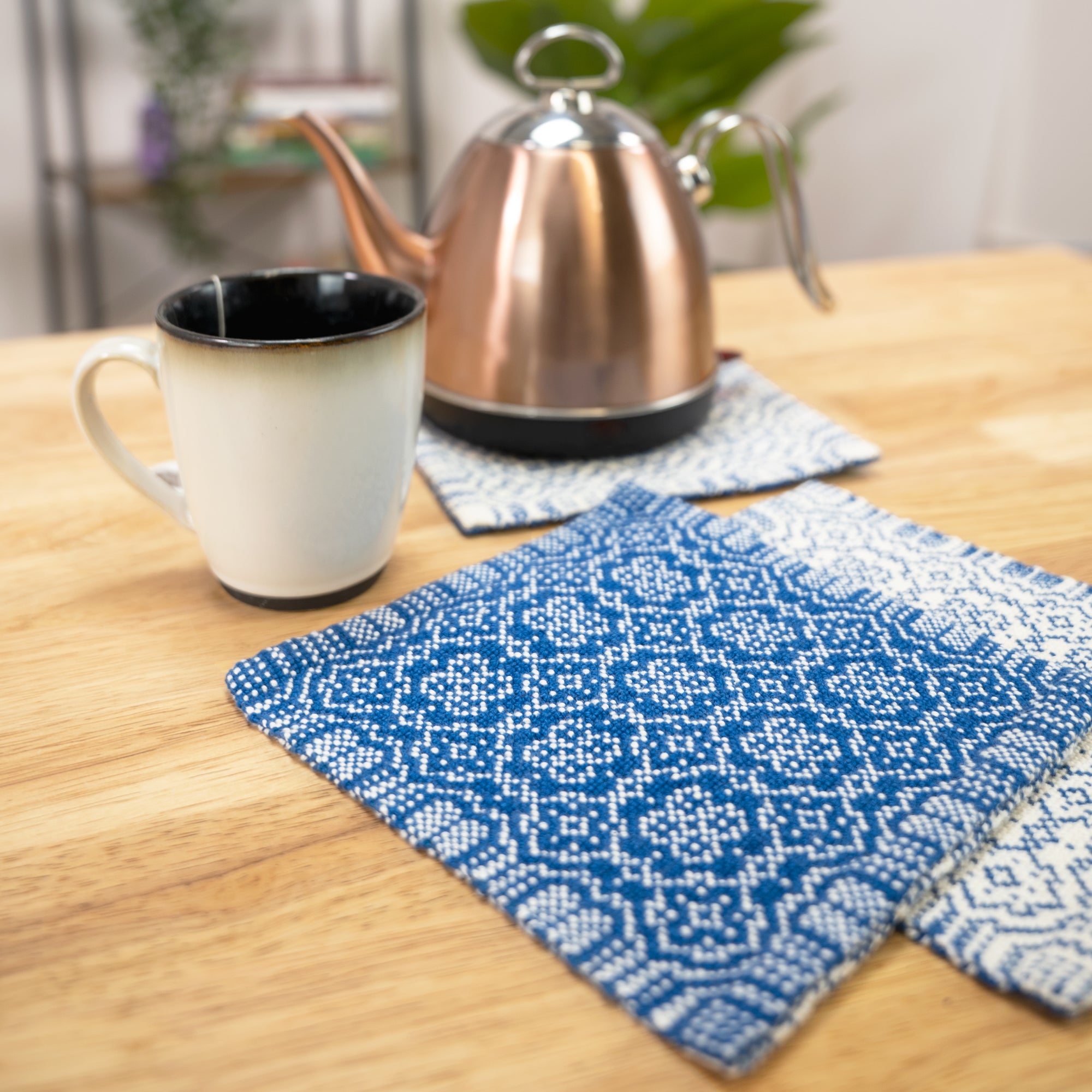Flower Garden Hot Pads
Designed and woven by Malynda Allen
I love overshot patterned doubleweave because I can make beautiful patterns with a plain weave surface on a four-shaft loom. Doubleweave creates two layers of fabric, and I chose a heavy cotton yarn, so these hot pads are naturally thick enough to protect your hands and surfaces from pans straight from the oven or stove.
For these hot pads, we will weave three different designs, each with a different treadling or tie-up. You may choose to weave two hot pads of each design or play with your own twill treadlings for one-of-a-kind pot holders.
I have written this draft in overshot, and you may take it directly to loom as if it were a profile draft. Each dark thread represents two warp ends: one dark and one light, threaded on opposite shafts. It may sound complicated, but it is easier once you begin and see how it works.
Project Specs
Finished size: 6 hot pads, each 7-1/2" x 7-1/2"
Weave structure: overshot patterned doubleweave
Number of warp ends: 218 (109 per layer)
Warp length: 2-3/4 yards, including 9" for take-up and 27" for loom waste. This warp length allows 10-1/2" of warp length per hot pad.
Download profile threading PDF
Download tie-up and treadling variations PDFWhat You'll Need
-
3/2 perle cotton in one dark and one light color, 550 yards each. I used Georgia Yarn Company in Natural, 325 yards for the warp and 225 yards for the weft; Valley Yarns in Sapphire, 325 yards for the warp and 225 yards for the weft.
You can substitute with 8/4 unmercerized cotton with similar results.
-
Wolf Pup LT or any 4-shaft loom with at least a 10" weaving width
-
12 dent reed
-
two shuttles and bobbins
-
sewing needle and thread to match the yarn
-
sewing machine (optional but recommended)
Materials
Equipment
Directions
Warping
Wind a warp 2-3/4 yards long, holding the light yarn and the dark yarn together, for a total of 218 ends (109 of each color).
Warp the loom with your preferred method. Sley the reed with 1 end of dark yarn and 1 end of light yarn per dent. Thread the heddles according to the profile draft.
Remember:
When the draft shows a warp end on A, thread a dark end on shaft 1, followed by a light end on shaft 3.
When the draft shows a warp end on B, thread a dark end on shaft 2, followed by a light end on shaft 4.
When the draft shows a warp end on C, thread a dark end on shaft 3, followed by a light end on shaft 1.
When the draft shows a warp end on D, thread a dark end on shaft 4, followed by a light end on shaft 2.

Weave a header with two colors of scrap yarn using a simple straight twill treadling. As you work the header, check both sides of the weaving for threading errors.
Varying the Tie-Up and Treadling
I changed the treadling of my hot pads for three different designs: I worked two hot pads each in Star treadling, Rose treadling, and Alternate treadling. If you prefer, you can change the tie-up for each pair and work Star treadling throughout the weaving, for hot pads that look like mine. (Some weaving programs call this approach "shaft shuffling.") If you change the tie-up and the treadling, or substitute other twill tie-ups or treadlings, your hot pads will come out with different designs.

Weaving
Note: I wove two hot pads in Star treadling, two in Rose treadling, and two in the Alternate treadling. You can change the tie-up instead if you prefer.
Always follow a dark pick with a light pick, as shown in the profile draft. Weave following the draft. Weave 4 picks in contrasting yarn for a cutting line (two picks per layer of cloth).
After you weave the last hot pad, weave several picks with scrap yarn to secure the weft.
Finishing
Cut the weaving from the loom. Secure the weft with zigzag stitching at each end of the warp. If you prefer, cut the warp ends long and tie overhand knots.
Machine-wash the weaving and tumble dry until damp. Press and allow the weaving to dry completely.
Cut the hot pads apart at the contrasting yarn picks. Remove the contrasting yarn.
To hem, fold the raw edges of each layer to the inside and press. Slipstitch the folded edges together. Press again.

Notes
Resources
Estes, Josephine. Original Miniature Patterns for Handweaving, Part II, 1957. Draft 6: Foursome. https://www2.cs.arizona.edu/patterns/weaving/monographs/eje_min2.pdf
Moore, Jennifer. Doubleweave, Revised and Expanded. Interweave, 2019.
Scorgie, Jean. Weaver’s Craft, Issue 11, Vol. 3, No. 1, Spring 2002: Complementary Double Weave. https://www.weaverscraft.com/back_issues.html
Spady, Robyn. Heddlecraft. Issue 18, Nov./Dec. 2018. Overshot Patterned Doubleweave. https://heddlecraft.com/single-issues.html
van der Hoogt, Madelyn. The Best of Weaver’s: The Magic of Double Weave. XRX Books, 2006.










